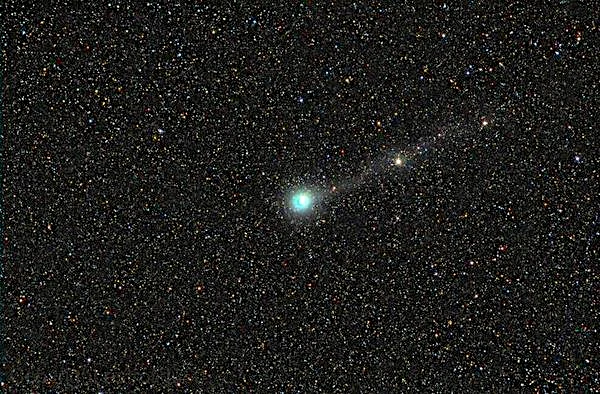
彗星レモン (C/2012 F6)2012 年から 2013 年にかけて、その明るい緑色と南半球での優れた視認性で印象を残しました。 プログラムによる発見レモン山調査アリゾナ州では、太陽系の氷の旅行者たちを活気づける化学的および物理的現象の完璧な例を提供します。
彗星というのは、氷の天体コンパウンド:
彗星が太陽に近づくとき(3~4天文単位以内)、氷の昇華作成します:
科学的メモ: 小惑星とは異なり、彗星は非常に偏心した軌道を描くことが多く、太陽系の境界 (オールトの雲) から太陽に近づきます。
| 特性 | 値/詳細 |
|---|---|
| 正式名称 | C/2012 F6 (レモン) |
| 発見日 | 2012 年 3 月 23 日 (米国アリゾナ州レモン山調査) |
| 軌道の種類 | 双曲線 (非周期的) |
| 近日点 | 0.73AU (2013 年 3 月 24 日) |
| 最大等級 | ~5.5 (2013 年 1 月) |
| 特徴的な色 | 緑色 (518 nm での C₂ 発光) |
| 可視性 | 南半球(2012年12月~2013年4月) |
| 最短距離 地球 | 0.98AU (2013 年 2 月 5 日) |
| 発見者 | A.R.ギブス |
| 注目すべき構成 | 二原子炭素(C₂)、シアン(CN)、ケイ酸塩ダスト |
注: :
周回彗星双曲線レモンのように、おそらくどこから来たのでしょうオールトの雲そして太陽の近くに一度だけ戻ってから、太陽系内部を完全に離れます。
レモン彗星のエメラルドの色合いは、次のような現象によって生じます。蛍光 :
| 日付 | イベント | マグニチュード | 位置 |
|---|---|---|---|
| 2012 年 3 月 23 日 | A.R.による発見ギブス | 20.8 | - |
| 2012 年 12 月 | 双眼鏡で見えるようになる | <10 | 南半球 |
| 2013 年 1 月 9 日 | ピーク可視性 | 5.5 | 射手座 |
| 2013 年 3 月 24 日 | 近日点への通過 | ~6 | 太陽から0.73天文単位 |
| 2013 年 4 月 | 徐々に消滅 | > 10 | - |
注: :
そこにはマグニチュード5.5完全な黒い空の下での肉眼での視認限界に相当します。市内では、その規模で、4以下通常、機器を使用せずに観察する場合に必要です。
| 設備の種類 | 特徴 | 考えられる観察 |
|---|---|---|
| 肉眼 | 暗い空 (限界等級 > 6) | ぼやけたコマ(詳細なし) |
| 双眼鏡 | 10×50または20×80 | 昏睡状態と短い尾が見える |
| 望遠鏡 | 開口部 ≥ 150 mm | コマの詳細、ダストテール |
| 写真 | APN + 長時間露光 (20 ~ 60 秒) | 延長テール、カラー(トリートメントあり) |
注: :
フィルタースワンバンドまたはC₂写真でガス構造を強調できますが、全体的な光は減少します。30~50%。
彗星レモン (C/2012 F6)双曲線軌道をたどるということは、おそらく定期的に太陽系内部に戻ることはないでしょう。 周期彗星(ハレー彗星のような、周期 ≈ 76 年)は、正確な間隔で定期的に戻ってきます。 双曲彗星は開いた軌道を持っています。太陽の近くを 1 回以上通過することも、星間空間に向かって永久に遠ざかることもできます。 実際には、彗星は太陽から遠ざかりつつあり、その軌道からは古典的な「周期」を定義することはできません。
注: :
双曲彗星は、周期彗星とは異なり、通常の接近通過は期待できません。将来の観測は例外的であり、人類規模では予測不可能となるでしょう。
| 年 | 太陽からの最小距離 | 地球からの推定距離 | 備考 |
|---|---|---|---|
| 2012-2013 | 0.73AU | 0.98AU | 南半球から見た航路 |
| 2100(シミュレーション) | ~5AU | ~4.8AU | 遠くの通路、肉眼では見えない |
| 2025年 | 0.72 AU (太陽に大接近) | ≈ 0.95AU | 南半球では肉眼での観察が可能 |
注: :
双曲彗星は、周期彗星とは異なり、規則的な接近通過を持ちません。将来の観測は例外的であり、人類規模では非常に不確実なものとなるでしょう。